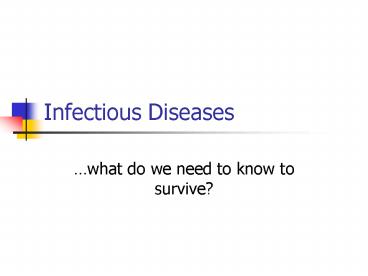Infectious Diseases - PowerPoint PPT Presentation
1 / 26
Title:
Infectious Diseases
Description:
Fleas. Ticks. Nonliving. Prions Mad cow disease, scrapie, JCD. Classifying Infectious Diseases ... Symptom A change in body function that is felt by a patient ... – PowerPoint PPT presentation
Number of Views:43
Avg rating:3.0/5.0
Title: Infectious Diseases
1
Infectious Diseases
- what do we need to know to survive?
2
Bacteria are everywhere
3
Infectious Microbes
4
Infectious Agents
- Bacteria
- Cholera
- TB
- E coli
- Viruses
- HIV
- HPPV
- Hepatitis
- Protozoa
- Malaria
- Giardia
- Multicellular
- Schistosomiasis
- Tapeworm
- External organisms
- Fleas
- Ticks
- Nonliving
- Prions Mad cow disease, scrapie, JCD
5
Classifying Infectious Diseases
- Symptom A change in body function that is
felt by a patient as a result of disease - Sign A change in a body that can be measured
or observed as a result of disease. - Syndrome A specific group of signs and
symptoms that accompany a disease.
6
Occurrence of Disease
- Endemic disease Disease constantly present
in a population. - Epidemic disease Disease acquired by many
hosts in a given area in a short time. - Pandemic disease Worldwide epidemic.
- Herd immunity Immunity in most of a
population.
7
Transmission of Disease
Figure 14.6a 8
8
Reservoirs of Infection
- Reservoirs of infection are continual sources of
infection. - Human AIDS, gonorrhea
- Carriers may have inapparent infections or latent
diseases - Animal Rabies, Lyme disease, Influenza
- Some zoonoses may be transmitted to humans
- Nonliving Botulism, tetanus
- Soil
9
Kochs Postulates
- Koch's Postulates are used to prove the cause of
an infectious disease.
Figure 14.3.1
10
Kochs Postulates
- Koch's Postulates
- Showed that infections can be transmitted
- Can prove the cause of an infectious disease.
Figure 14.3.2
11
Why are bacteria toxic?
- Compete for nutrients in host
- Secrete toxins
- Destroy tissues
- Waste products are harmful
12
Bacterial Shapes
http//content.answers.com/main/content/img/elsevi
er/dental/f0396-02.jpg
13
Antibiotic Resistance
- A variety of mutations can lead to antibiotic
resistance. - Mechanisms of antibiotic resistance
- 1. Enzymatic destruction of drug
- 2. Prevention of penetration of drug
- 3. Alteration of drug's target site
- 4. Rapid ejection of the drug
- Resistance genes are often on plasmids or
transposons that can be transferred between
bacteria.
14
Antibiotic Resistance
- Misuse of antibiotics selects for resistance
mutants. Misuse includes - Using outdated, weakened antibiotics
- Using antibiotics for the common cold and other
inappropriate conditions - Use of antibiotics in animal feed
- Failure to complete the prescribed regimen
- Using someone else's leftover prescription
15
Viruses and Viral Infections
- Why are viruses both dead and alive?
- How do they cause infection?
- How do we get rid of them?
16
Types of infections
- Acute Viral Infections
- Virus remains a short time
- Eliminated by host response (rhinovirus, swine
flu) - Latent Viral Infections
- Virus remains in asymptomatic host cell for long
periods - Cold sores, shingles
- Persistent Viral Infections
- Disease processes occurs over a long period,
generally fatal - Subacute sclerosing panencephalitis (measles
virus) - Hepatitis
17
Virus Shapes
Figure 13.4a, b
18
Attachment, Penetration, and Uncoating
http//www.fli.bund.de/uploads/pics/infektion-e_01
.jpg
Figure 13.14
19
Swine Flu (H1N1)
H antigen Influenza viruses bind through
hemagglutinin onto the surfaces of epithelial
cells N antigen Neuraminidase (enzyme allows
the virus to exit from the cell. Serotypes
(numbers) Variations in protein structure
(mutations) RNA Can be collected from viral
coinfections of human, swine or bird, or all
three.
20
Antiviral Drugs - Enzyme Inhibitors
- Protease inhibitors
- Indinavir
- HIV
- Neuraminidase inhibitor
- Oseltamivir
- Influenza
- Inhibit attachment
- Zanamivir
- Influenza
- Inhibit uncoating
- Amantadine
- Influenza
- Interferons prevent spread of viruses to new
cells - Viral hepatitis
21
HIV Infection
22
Acquired Immunodeficiency Syndrome (AIDS)
Figure 19.12a
23
Oncogenic Viruses
- Oncogenic RNA viruses
- Retroviridae
- Viral RNA is transcribed to DNA which can
integrate into host DNA - HTLV 1
- HTLV 2
- Oncogenic DNA Viruses
- Adenoviridae
- Herpesviridae (EBV)
- Poxviridae
- Papovaviridae (HPV)
- Hepadnaviridae HepB
24
Cancer
- Activated oncogenes transform normal cells into
cancerous cells. - Transformed cells have increased growth, loss of
contact inhibition, tumor specific transplant and
T antigens. - The genetic material of oncogenic viruses becomes
integrated into the host cell's DNA (e.g. Human
papilloma virus vaccine).
25
Prions proteinaceous infectious (-on by analogy
to virion)
- Infectious proteins CANNOT BE KILLED
- Inherited and transmissible by ingestion,
transplant, surgical instruments - Spongiform encephalopathies Sheep scrapie,
Creutzfeldt-Jakob disease, fatal familial
insomnia, mad cow disease - PrPC, normal cellular prion protein, on cell
surface - PrPSc, scrapie protein, accumulate in brain cells
forming plaques
26
Prion Pathogenesis
Normal prions may function in long term memory
Spongiform encephalopathy
http//www.ens-newswire.com/ens/jul2006/2006-07-10
-03.asp































